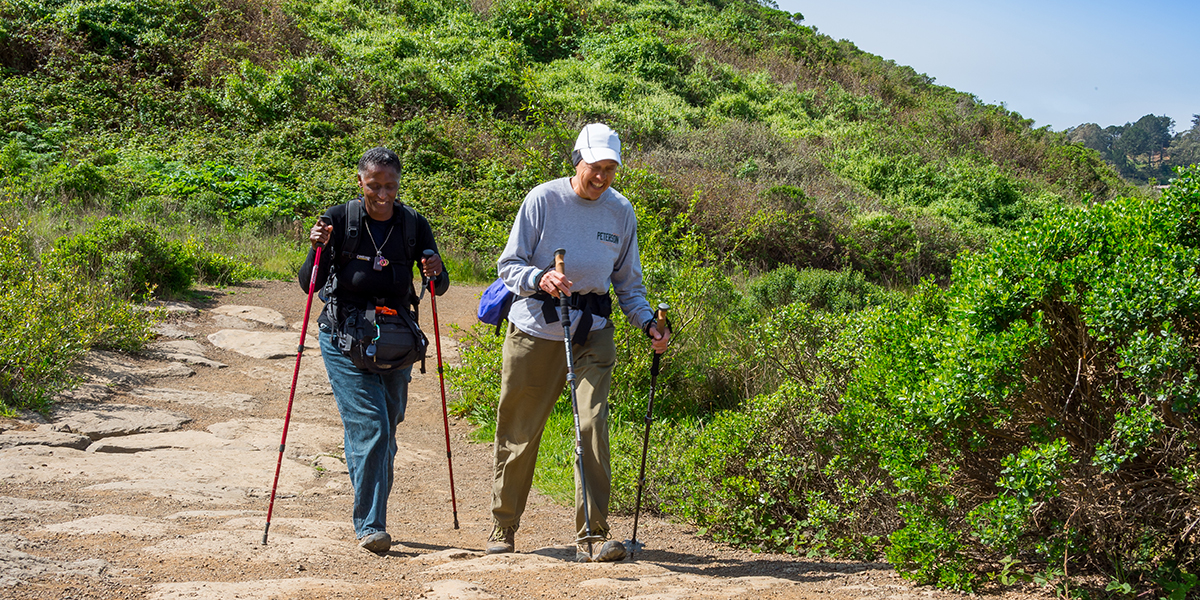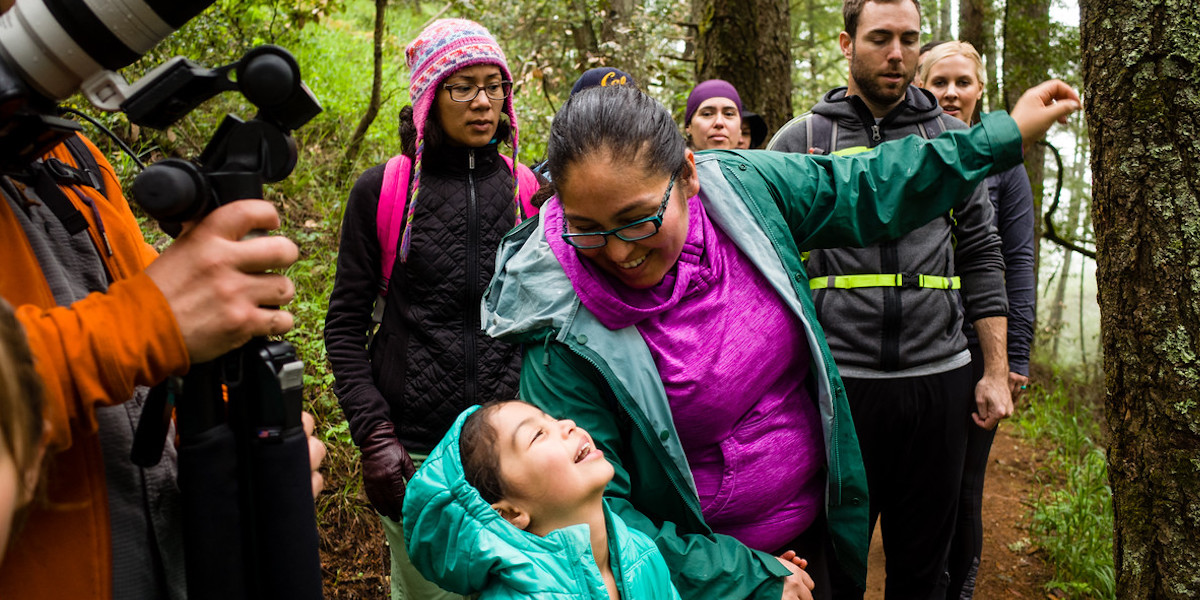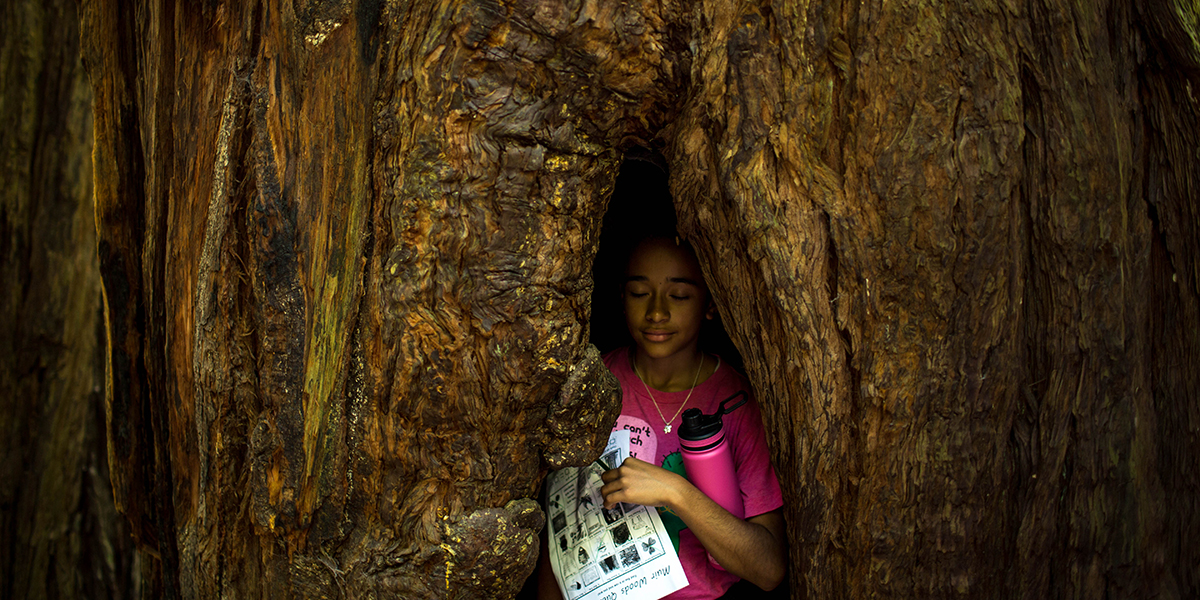Health Benefits of Nature
How the outdoors improve your physical and mental wellness

Rachel Styer / Presidio Trust
Enjoying the wonders of the outdoors is a small act that has big health benefits. Whether venturing out your front door, cruising down a tree-lined street, or visiting your neighborhood park, being surrounded by the green spaces and the natural world is profoundly healing cognitively, emotionally, and physically. Some studies have even found that viewing nature virtually, like watching nature documentaries or looking at photos, can help one’s overall wellness.
That’s why we believe in the power of Park Prescriptions (ParkRx). ParkRx programs are designed in collaboration with public land agencies, health care providers, and community partners to improve individual and community health. The Parks Conservancy has helped support the growth of this concept since 2010. With our national partners, we have helped create a suite of tools and resources to generate knowledge and promote learning. This includes a Park Prescription Program toolkit and ParkRx.org.
How nature helps physical health and wellness:
The more time outside, the more it’ll benefit your overall health

Research from the Harvard T.H. Chan School of Public Health reinforces what many park lovers already know: Time in nature can significantly improve both physical and mental well-being.
Spending at least 120 minutes a week in nature is associated with good health and well-being, according to another scientific report. The report also found that living in greener urban areas is associated with "lower probabilities of cardiovascular disease, obesity, diabetes, asthma hospitalization, mental distress, and ultimately mortality, among adults; and lower risks of obesity and myopia in children."
A 2016 study examined the relationship between access to local greenery and mortality risk. Compared to people with the least greenery in their neighborhoods, people with the most greenery were 34 percent less likely to die from respiratory diseases.
Getting outside and physical activity lessen obesity rates while breaking sedentary habits
Unstructured physical activity—also known as “free time”—for children improves their overall health. Research shows it reduces the likelihood of obesity and weight-related health concerns.
Exposure to green spaces lowers risks for diabetes and also decreases blood sugar levels among diabetics.
Specifically for people with Type 2 diabetes, a study found walks in the forest—or green spaces in general—showed a decrease in blood glucose levels after a forest walk.
Natural environments and sunlight can improve sleep quality by resetting circadian rhythms
Research found time outdoors and in sunlight is associated with improved sleep.

Time outside can improve eyesight in children
Children who spend more time outdoors have reduced rates of nearsightedness, or myopia, according to a 2021 scientific report. Going outside can also maintain your eyesight by reducing eye strain from staring at screens or artificial lights indoors.
Immersing in nature—particularly forests—boosts immune function
Forest bathing , also known as shinrin-yoku in Japanese, means “bathing in the essence of the forest” and is scientifically proven to aid our physical, mental, and emotional well-being. A study in Japan found that phytoncides, volatile organic compounds or “essential oils” given off by plants and trees, released from trees and the decreased production of stress hormones may partially contribute to the increased immune response and may have a preventive effect on cancer generation and development. When we breathe in these chemicals, our bodies respond by increasing the number and activity of a type of white blood cell called natural killer cells.
Sunlight increases natural Vitamin D production, which is linked to improved health outcomes
A 2008 study found that vitamin D, which helps the body build bones by absorbing and retaining calcium and phosphorus, is synthesized in the skin through a photosynthetic reaction triggered by exposure to ultraviolet B (UVB) radiation in sunlight.
Ultraviolet (UV) rays can also damage skin cells and cause skin cancer. The Centers for Disease Control and Prevention recommends to wear protection from UV rays all year and not just during the summer months or when it’s sunny out.
Going outdoors for fresh air can improve breathing and reduce your risk for respiratory diseases
Research has shown that vegetation in urban parks can clean the air of pollutants.
How the outdoors helps mental, emotional, cognitive health and wellness:

Nature inspires the sensation of “awe,” which decreases stress, anxiety, and depression
The act of being outside exposes you to natural light, greenery, and sounds that in turn, according to the National Forest Service, reduces our stress response, cortisol levels, muscle tension, blood pressure and heart rates–all of which are risk factors for cardiovascular disease.
In a 2018 study, researchers attributed the benefits we experience being in nature is caused by the sensation of “awe” and wonder.
“Our findings suggest that you don’t have to do extravagant, extraordinary experiences in nature to feel awe or to get benefits,” writes researcher Craig Anderson. “By taking a few minutes to enjoy flowers that are blooming or a sunset in your day-to-day life, you also improve your well-being.”
Greenery boosts happiness and morale while reducing stress hormones, making you feel more “alive”
Spending time walking among—or simply looking at trees from a window—lowers blood pressure and reduces the stress-related hormones cortisol and adrenaline which in turn improves our mood.
There is evidence that shows it doesn’t take much time to get the benefits of being outside. Spending just 20 minutes in a local park is enough to improve well-being.
Exposure to nature has been associated with decreased activity of the "rumination center" in our brain and, according to one study, reduces maladaptive pattern of self-referential thought that is associated with heightened risk for depression and other mental illnesses.
Natural spaces relieve attention fatigue, aids recovery, and bolsters creativity and problem-solving skills
Psychologists have found that nature restores our physical and mental wellness, as detailed in the “Green is good for you” study by the American Psychological Association.
Researchers also found that playtime in natural environments for kids has shown to improve restoration and tests of cognitive performance.
Nature and being outside improves short-term memory and attention deficits
Experiments have found exposure to natural environments “improves working memory, cognitive flexibility and attentional control, while exposure to urban environments is linked to attention deficits.”

The outdoors can improve ADHD symptoms, including inattention and impulsivity, in both adults and kids
A national study conducted in the U.S. found that green outdoor activities—no matter the setting—reduced symptoms significantly more than did activities conducted in other settings. Those finders we consistent across socioeconomic groups, age, and gender. Being in nature, allows us to shift to recover from situational inattention and impulsivity.
Researchers found that “’Doses of nature’ might serve as a safe, inexpensive, widely accessible new tool in the tool kit for managing ADHD symptoms.”
Researchers found that exposure to a natural environment—even looking outdoors through a window—helps improve attention and mental health.
For the elderly, time in a natural setting can improve cognition
A 2007 study found “concentration increase for very elderly people after a visit to a garden outside the geriatric home.”








